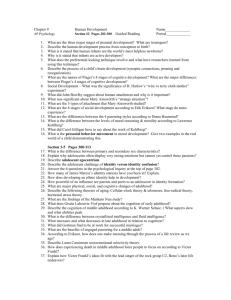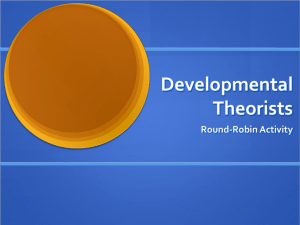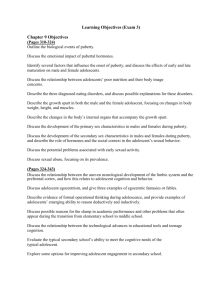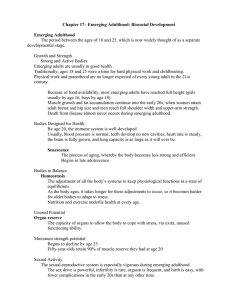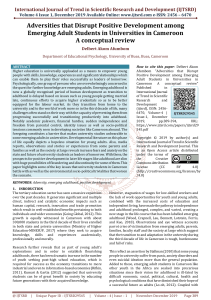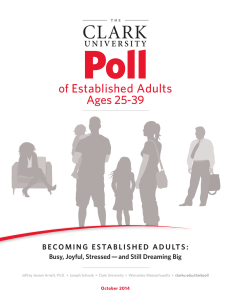Considerations for Adolescent and Adult Milestones
advertisement
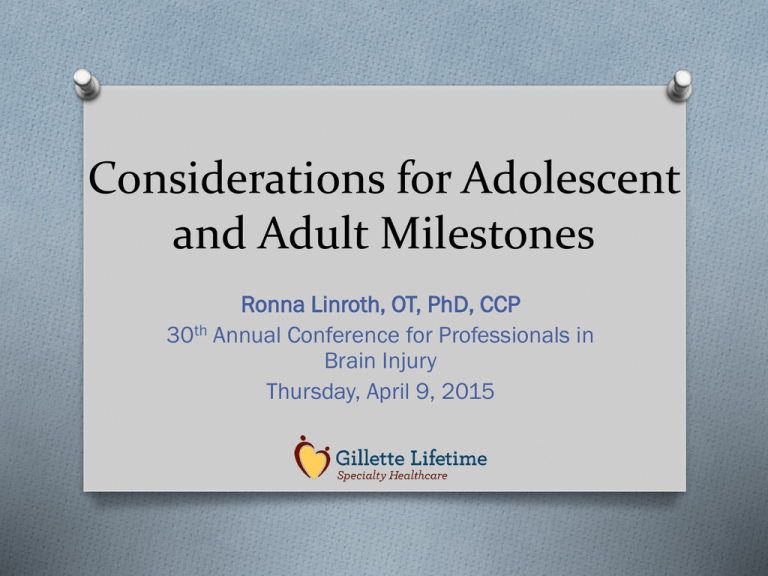
Considerations for Adolescent and Adult Milestones Ronna Linroth, OT, PhD, CCP 30th Annual Conference for Professionals in Brain Injury Thursday, April 9, 2015 Learning Objectives O Participants will identify the four primary areas of emerging adult milestones O Participants will have a working definition of Transition as a process. O Participants will assess their program for needed next steps for professional and patient support during transition. Brain development O There is now no doubt that adolescence should O O O O be treated as a special period. Striking changes in the white and gray matter take place between 11 and 25 years of age. May lead to abrupt behavioral change & attendant risk. Brain becomes flexible and able to respond quickly and imaginatively. Healthcare providers need to approach health management within the context of transition to adulthood. Pediatric Head Injury “Severe head injury in childhood may appear to be followed by striking recovery to the developmental stage the child had reached before injury. However, after a number of settled years significant behavioral, attentional and psychological problems may then appear in the teenage years due to underlying damage to the grey matter and the white matter tracts being masked until the maturation phases of adolescent brain development begin.” O Colver & Longwell, (2013), pg 904 Transition Early stage Middle stage Late stage 12-14 15-17 18+ Healthcare Transition O Transition is the planned process [preparation] and purposeful movement into adult oriented care (Patterson, 1999). O Transfer of care is an event or events- the switch from pediatric oriented medical care providers to adult oriented medical care providers. Components of Successful Transition O Self-Determination O Person Centered Planning O Preparation for adult health care O Work /Independence O Inclusion in community life Introducing the theory of Emerging Adulthood Emerging Adult Milestones Jeffrey Arnett in 2000, American Psychology O A phase of the lifespan between late adolescence and full-fledged adulthood O (age 18-29) O Applies to young adults in developed countries who O Do not have children O Do not live in their own home O Do not have sufficient income to become fully independent Cognitive Development during this phase: O Connections within the brain are still being strengthened and unused are pruned O Brain structures develop for O greater processing of emotions and social information O greater planning and assessment of risk/rewards O “Emerging adulthood is a critical stage for the emergence of complex forms of thinking required in complex societies.” (Gisela Labouvie-Vief, 2006) 5 features of emerging adults O Age of identity exploration. O Age of instability. O Age of self-focus. O Age of feeling in between. O Age of possibilities. Emerging adults want a lot out of life! O Some struggle and some prosper O How well an adolescent makes the transition through young adulthood into adulthood and becomes a fully independent person depends in large part on the right balance of the adolescent pushing for independence and parents and society giving the correct amount of support--not pushing too hard or holding back too much. (Tanner, 2004) Two processes occurring in Emerging Adults O Re-centering: Shifting from dependence on parents to system commitments (careers, intimate partners, children) O Ego Development: agency, self-regulation, impulse control, learning to stand alone, constructing life plans Arnett’s 4 areas of focus O Employment O Education O Independent living O Maturing relationships Gillette’s Transition Clinic O Designed to assist patients and families in their transition from a pediatric care model to an adult care model. O Help is provided to assist in identifying skills and knowledge needed to navigate the adult specialty healthcare environment. O Visit includes review of medical history, readiness self-assessment, interview, goalsetting, referrals to services needed to assure continuity of care. Most frequently identified needs through screening tool: • Assistance with transportation • Future living situation, i.e., group home, remain with family, independent living • Future vocation Lessons Learned Patients and families present as unprepared for transition. Parent needs for transition support are often as great as those of patient. Discussion needs to start early Creation and distribution of educational tools to providers, staff, and families is essential. Most transition patients do not carry any identification Attachments between patient/family and pediatric providers/staff is very strong Lessons, continued Pediatric primary care providers have told many patients to find an adult primary care provider. This is proving difficult for many patients and families Difficult and often emotional when parent is asked to leave the patient alone with provider Care coordination is essential for successful transition. Assessing for Transition Support Six Core Elements for Health Care Transition Transition supports are needed during adolescence and early adulthood “It is sort of unfair to expect [teens] to have adult levels of organizational skills or decision-making before their brains are finished being built.” Resources gottransition.org is the website for the Center for Health Care Transition References O "Emerging Adulthood: The Winding Road From the Late Teens Though the Twenties“, 2nd Ed. (Oxford University Press, 2014). O “Pediatric to Adult Transition: A Quality Improvement Model for Primary Care”(2014) Journal of Adolescent Health, 56, 73-78. O Credit for images: Bing.com http://www.bing.com/images/search?q=images+o f+brain+development&qpvt=images+of+brain+dev leopment&qpvt=images+of+brain+devleopment&F ORM=IGRE Answers are not guaranteed but we can have a great discussion! Thank you!


